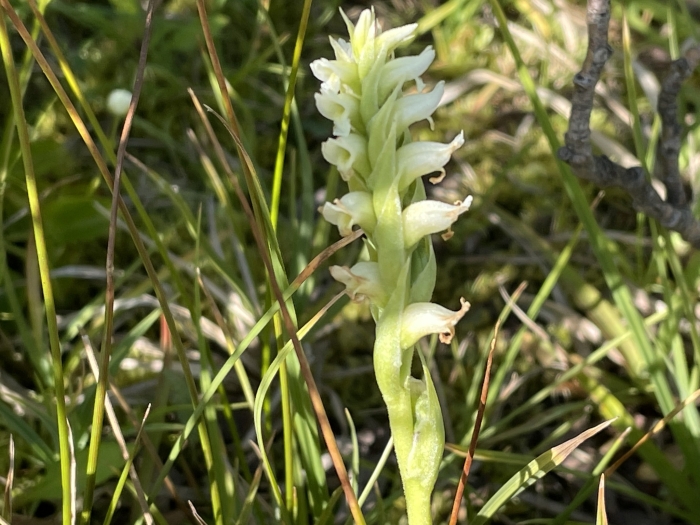Hooded Lady’s Tresses
(Spiranthes romanzoffiana)
Hooded Lady’s Tresses (Spiranthes romanzoffiana)
/
/

Henrik Kibak
CC BY 4.0
Image By:
Henrik Kibak
Recorded By:
Copyright:
CC BY 4.0
Copyright Notice:
Photo by: Henrik Kibak | License Type: CC BY 4.0 | License URL: http://creativecommons.org/licenses/by/4.0/ | Rights Holder: Henrik Kibak | Publisher: iNaturalist | Date Created: 2022-08-16T23:31:51Z |

























Estimated Native Range
Summary
Spiranthes romanzoffiana, commonly known as hooded lady’s tresses or Irish lady’s-tresses, is a perennial orchid that is deciduous in nature. It is native to moist meadows, fens, bogs, and along the edges of streams and lakes in North America, as well as wet grasslands in Ireland and the British Isles. This orchid typically grows to a height of 10 to 60 centimeters and has a slender, leafy stem with lanceolate leaves that are mostly basal. The plant is notable for its spirally arranged, fragrant white flowers that bloom in late summer. Each flower is distinct with sepals and petals that unite to form a hooded, tube-like lip, which is attractive to a variety of insect pollinators.
Hooded lady’s tresses is valued for its ornamental, fragrant flowers and is used in wildflower gardens, bog gardens, and naturalized areas. It requires consistently moist soil conditions and can tolerate partial shade, although it thrives in full sun. This orchid benefits from a symbiotic relationship with mycorrhizal fungi, which assist in nutrient uptake, making it a fascinating example of plant-fungal cooperation. While generally low-maintenance, it can be sensitive to drought and excessive disturbance. It is not known for aggressive roots or significant disease problems, but over-collection and habitat destruction have impacted some wild populations. Cultivation should focus on protecting its delicate root system and providing a stable environment similar to its natural habitat.CC BY-SA 4.0
Hooded lady’s tresses is valued for its ornamental, fragrant flowers and is used in wildflower gardens, bog gardens, and naturalized areas. It requires consistently moist soil conditions and can tolerate partial shade, although it thrives in full sun. This orchid benefits from a symbiotic relationship with mycorrhizal fungi, which assist in nutrient uptake, making it a fascinating example of plant-fungal cooperation. While generally low-maintenance, it can be sensitive to drought and excessive disturbance. It is not known for aggressive roots or significant disease problems, but over-collection and habitat destruction have impacted some wild populations. Cultivation should focus on protecting its delicate root system and providing a stable environment similar to its natural habitat.CC BY-SA 4.0
Plant Description
- Plant Type: Herb
- Height: 0.75-2.5 feet
- Width: 0.25-0.5 feet
- Growth Rate: Moderate
- Flower Color: White
- Flowering Season: Summer, Fall
- Leaf Retention: Deciduous
Growth Requirements
- Sun: Full Sun, Part Shade
- Water: High
- Drainage: Medium, Slow
Common Uses
Bee Garden, Butterfly Garden, Low Maintenance, Water Garden
Natural Habitat
Moist meadows, fens, bogs, and stream and lake edges in North America, and wet grasslands in Ireland and the British Isles
Other Names
Common Names: Hooded Ladies’ Tresses, Irish Lady’s-Tresses, American Lady’s Tresses
Scientific Names: , Spiranthes romanzoffiana, Gyrostachys gemmipara, Gyrostachys romanzoffiana, Gyrostachys romanzowiana, Gyrostachys stricta, Ibidium romanzoffianum, Ibidium romanzoffianum var. strictum, Ibidium strictum, Neottia gemmipara
GBIF Accepted Name: